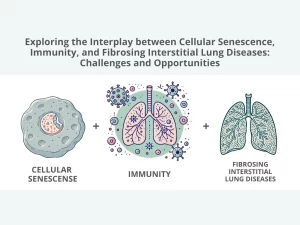Peripheral Immune Cell Profiling Reveals Distinct Immune Hallmarks in Progressive Pulmonary Fibrosis

Observational study scope
This observational study included 33 patients with f-ILDs, other than IPF. Diagnosis of ILDs was established through a multidisciplinary discussion based on clinical characteristics along with HRCT scan, bronchoalveolar lavage, and lung biopsy patterns if appropriate.
Disease progression was defined as per international guidelines (ATS/ERS/JRS/ALAT), by ≥2 of the following criteria: worsening respiratory symptoms, lung function progression (absolute change in FVC ≥5% and/or DLCO ≥10%) and/or radiological progression.
33.3% patients exhibited PPF during follow-up
Eleven patients (33.3%) exhibited PPF during follow-up, whereas 22 (66.7%) remained stable. Table 1 presents the main demographic and clinical characteristics of these two groups at diagnosis, with further stratification by non-idiopathic pulmonary fibrosis subtypes available in Table S1.
Age, gender, smoking status and proportion of f-ILD subtypes were similar across main groups. Most patients were naïve to immunosuppressive and antifibrotic treatment.
In the entire population studied (n=33), we found significant correlations between several blood immune markers and lung function.
(…)
Novel Observations
The main and novel observations of this study are that:
- In the entire population of f-ILDs, several CD8 and CD4 subpopulations correlate with lung function severity at the time of diagnosis and
- NKT-like cells levels at diagnosis are associated with PPF.
(…)
In summary
This study shows that in patients with f-ILDs several immune populations in circulating blood, skewed toward an aged and exhausted immune profile, relate to lung function impairment at diagnosis, and that PPF is associated with an increased cytotoxic immune response. Collectively, these findings highlight biomarkers of potential clinical utility, although we acknowledge that these observations will have to be confirmed in larger cohorts.
Authors
Fernanda Hernandez-Gonzalez, Nuria Mendoza, Sandra Casas-Recasens, Tamara Cruz, Nuria Albacar, Gemma López-Saiz, Xavier Alsina-Restoy, Mauricio Rojas, Alvar Agusti, Jacobo Sellarés, Rosa Faner.
Read more
Noticias relacionadas

Falling through the cracks: what happens to survivors of preterm birth?
Survivors of preterm birth face increased risks of respiratory diseases, yet awareness among specialists is low. This study examines gaps in long-term care, highlighting the need for clear follow-up guidelines and improved communication between medical teams.

The impact of the EVLP on the lung microbiome and its inflammatory reaction
Discover the first study designed to analyze the impact of EVLP on the lung microbiome and the local inflammatory response. Understanding the composition, diversity, and functional interactions of the pulmonary microbiome in lung transplants holds promise for personalized respiratory medicine.

Exploring the Interplay between Cellular Senescence, Immunity, and Fibrosing Interstitial Lung Diseases: Challenges and Opportunities
Discover how cellular senescence, marked by antagonistic pleiotropy, and immune dysregulation play a detrimental role in the pathogenesis of fibrosing interstitial lung diseases (f-ILDs) and pulmonary fibrosis.
Artículos
Fibrosis
- 768786·Mate Maus et al. Iron accumulation drives fibrosis, senescence and the senescence-associated secretory phenotype
- 769072·Tamara Cruz et Al. – Lung immune signatures define two groups of end-stage IPF patients
- 769275·Nuria Mendoza et al. Blood Immunophenotypes of Idiopathic Pulmonary Fibrosis: Relationship with Disease Severity and Progression
- 779185·Vincent Cottin et Al. Syndrome of Combined Pulmonary Fibrosis and Emphysema. An Official ATS/ERS/JRS/ALAT Research Statement.
- 779376·Gerard J. Criner, Alvar Agusti, Hossein Borghaei, Joseph Friedberg, Fernando J. Martinez, Curtis Miyamoto, Claus F. Vogelmeier, Bartolome R. Celli.Chronic Obstructive Pulmonary Disease and Lung Cancer: A Review for Clinicians
Estudios
- 759397·Alberto Sandiumenge et Al.-Systemic Inflammation Differences in Brain-vs. Circulatory-Dead Donors: Impact on Lung Transplant Recipients
- 759578·Alberto Papi et Al.-Relationships between symptoms and lung function in asthma and/or chronic obstructive pulmonary disease in a real-life setting: the NOVEL observational longiTudinal studY
- 759689·Kilian Vellvé et Alt.- Pulmonary vascular reactivity in growth restricted fetuses using computational modelling and machine learning analysis of fetal Doppler waveforms.
- 769273· Singh D, Criner GJ, Agustí A et al. Benralizumab Prevents Recurrent Exacerbations in Patients with Chronic Obstructive Pulmonary Disease: A Post Hoc Analysis
- 769685·Nuria Olvera et Al.- Lung Tissue Multi-Layer Network Analysis Uncovers the Molecular Heterogeneity of COPD
Imagen creada con imágenes libres de Canva Pro.
